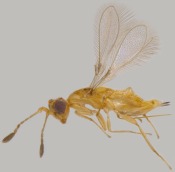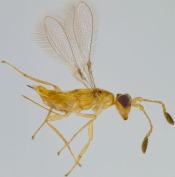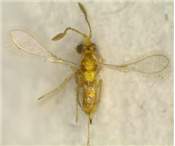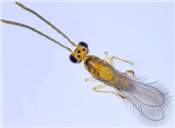 Fig 1. Female, dorsal view |
 Fig 2. Female, latral view |
 Fig 3. Female, lateral view |
 Fig 4. Female, dorsal view |
 Fig 5. Male, dorsal view |
 Fig 6. Forewing |
Nomenclature
Stethynium Enock, 1909: 452. Type species: Stethynium triclavatum Enock, by monotypy.
Diagnosis
Stethynium belongs to the Anagrus group of genera and can be differentiated by the following characters.
- Female antennal clava 3-segmented, compact with sutures strongly oblique (Figs. 1-4)
- Posterior scutellum about twice as long as width of each lobe
- Fore wing with distinctly rounded basal lobe and smoothly rounded apex (Fig. 6), marginal vein very short, forming a smooth sigmoid curve with stigmal vein
- Mesophragma projecting into base of gaster with broadly rounded apically
Geographic Distribution
Worldwide, except Afrotropical (Lin et al., 2008).
View Distribution of Stethynium in India in a larger map
Hosts and habitat
Known hosts belong to Cicadellidae and gall-forming Eulophidae (Lin et al., 2007). Stethynium empoascae parasitizes Amrasca devastans Distant in India (Subba Rao and Hayat, 1983). The eucalyptus gall wasp, Ophelimus maskelli (Hymenoptera : Eulophidae) is parasitized by Stethynium opheolimi Huber and S. breviovipositor Huber, the only instance of mymarids as larval parasitoids of a holometabolous insect (Huber et al., 2006). These are considered as potential candidates for classical biological control of O. maskelli.
Species in India
1. empoascae Subba Rao, 1966 (original description); Triapitsyn (2002) (status discussion). (Distribution: Andaman and Nicobars, Delhi, Gujarat, Karnataka, Tamil Nadu)
2. triclavatum Enock, 1909 (original description); Huber (1987) (synonymy); Hayat (1992) (distribution) (Distribution: Tamil Nadu and Uttar Pradesh)
Note: Huber (1987) synonymized S. triclavatum with S. empoascae, but Zhang et al. (2010) synonymized S. empoascae under S. triclavatum. Triapitsyn (2002) was of the opinion that S. empoascae is morphologically extremely similar to the lighter colored specimens of S. triclavatum and it might be impossible to distinguish them in some countries like China, Egypt, India, Nepal, Pakistan etc. where both species can potentially occur together. Noyes (2012) lists it as a valid species.
References
Huber, JT. 1987. Review of Schizophragma Ogloblin and the non-Australian species of Stethynium Enock (Hymenoptera: Mymaridae). The Canadian Entomologist, 119: 823-855.
Enock, F. 1914. On a new genus of Mymaridae. Proceedings of the Entomological Society of London, 1913, cxxxiv.
Subba Rao, BR. 1966. Records of known and new species of mymarid parasites of Empoasca devastans from India. Indian Journal of Entomology, 28: 187-196.
Triapitsyn, SV. 2002. Review of the Mymaridae (Hymenoptera: Chalcidoidea) of Primorskii Krai: genera Cleruchus Enock and Stethynium Enock. Far Eastern Entomologist, 122: 1-13.
Ramesh Kumar et al., 2013